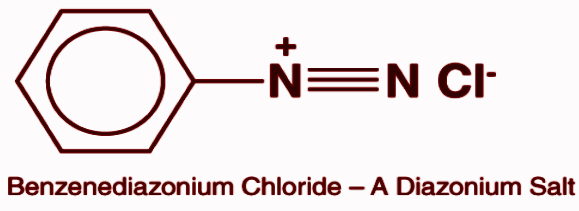
Methylamine reacts with \[HN{{O}_{2}}\]to form:
A. \[C{{H}_{3}}-O-N=O\]
B. \[C{{H}_{3}}-O-C{{H}_{3}}\]
C. \[C{{H}_{3}}OH\]
D. \[C{{H}_{3}}CHO\]
Answer
220.2k+ views
Hint: In this question, the intermediate step is the formation of aliphatic diazonium salt plays an important role in the completion of the reaction.
Complete Step by Step Solution:
In step 1, methylamine reacts with nitrous acid to form aliphatic diazonium salts. Diazonium salts are one of the most versatile combinations of organic and inorganic components. Its general way of representation is \[R-N_{2}^{+}{{X}^{-}}\].The\[R\] is an organic group, generally an aryl group while \[X\]represents an ion.
Generally, diazonium salts have\[C{{l}^{-}}\],\[B{{r}^{-}}\], \[BF_{4}^{-}\]as\[X\]. The name of these salts is based on the presence of the \[N_{2}^{+}\] group or the diazonium group. The naming of these salts is done by adding the suffix diazonium to the parent hydrocarbon from which they are derived and then it is followed by the anion \[X\] such as bromide.

\[C{{H}_{3}}-N{{H}_{2}}\xrightarrow{NaN{{O}_{2}}+HCl}C{{H}_{3}}-N_{2}^{+}C{{l}^{-}}\]
Since diazonium salts are unstable and are water-soluble. They further react with water.
\[C{{H}_{3}}-N_{2}^{+}C{{l}^{-}}\xrightarrow{-{{H}_{2}}O}C{{H}_{3}}-OH+{{N}_{2}}\uparrow +HCl\]
When unstable diazonium salt reacts with water it forms a stable compound that is methanol.
Hence, the correct option is option C that is\[C{{H}_{3}}OH\].
Note: The formation of the intermediate reactant that is diazonium salt should be correct and the reaction formed from the intermediate step should be accurate to get the desired product from the given reactant.
Complete Step by Step Solution:
In step 1, methylamine reacts with nitrous acid to form aliphatic diazonium salts. Diazonium salts are one of the most versatile combinations of organic and inorganic components. Its general way of representation is \[R-N_{2}^{+}{{X}^{-}}\].The\[R\] is an organic group, generally an aryl group while \[X\]represents an ion.
Generally, diazonium salts have\[C{{l}^{-}}\],\[B{{r}^{-}}\], \[BF_{4}^{-}\]as\[X\]. The name of these salts is based on the presence of the \[N_{2}^{+}\] group or the diazonium group. The naming of these salts is done by adding the suffix diazonium to the parent hydrocarbon from which they are derived and then it is followed by the anion \[X\] such as bromide.

\[C{{H}_{3}}-N{{H}_{2}}\xrightarrow{NaN{{O}_{2}}+HCl}C{{H}_{3}}-N_{2}^{+}C{{l}^{-}}\]
Since diazonium salts are unstable and are water-soluble. They further react with water.
\[C{{H}_{3}}-N_{2}^{+}C{{l}^{-}}\xrightarrow{-{{H}_{2}}O}C{{H}_{3}}-OH+{{N}_{2}}\uparrow +HCl\]
When unstable diazonium salt reacts with water it forms a stable compound that is methanol.
Hence, the correct option is option C that is\[C{{H}_{3}}OH\].
Note: The formation of the intermediate reactant that is diazonium salt should be correct and the reaction formed from the intermediate step should be accurate to get the desired product from the given reactant.
Recently Updated Pages
Electricity and Magnetism Explained: Key Concepts & Applications

JEE Energetics Important Concepts and Tips for Exam Preparation

JEE Isolation, Preparation and Properties of Non-metals Important Concepts and Tips for Exam Preparation

JEE Main 2021 July 25 Shift 1 Question Paper with Answer Key

JEE Main 2021 July 22 Shift 2 Question Paper with Answer Key

States of Matter Chapter For JEE Main Chemistry

Trending doubts
JEE Main 2026: Application Form Open, Exam Dates, Syllabus, Eligibility & Question Papers

Derivation of Equation of Trajectory Explained for Students

Hybridisation in Chemistry – Concept, Types & Applications

Understanding the Angle of Deviation in a Prism

How to Convert a Galvanometer into an Ammeter or Voltmeter

Understanding Centrifugal Force in Physics

Other Pages
Solutions Class 12 Chemistry Chapter 1 CBSE Notes - 2025-26

NCERT Solutions For Class 12 Chemistry Chapter 1 Solutions - 2025-26

The D and F Block Elements Class 12 Chemistry Chapter 4 CBSE Notes - 2025-26

NCERT Solutions for Class 12 Chemistry Chapter Chapter 7 Alcohol Phenol and Ether

NCERT Solutions ForClass 12 Chemistry Chapter Chapter 8 Aldehydes Ketones And Carboxylic Acids

JEE Advanced Marks vs Ranks 2025: Understanding Category-wise Qualifying Marks and Previous Year Cut-offs




